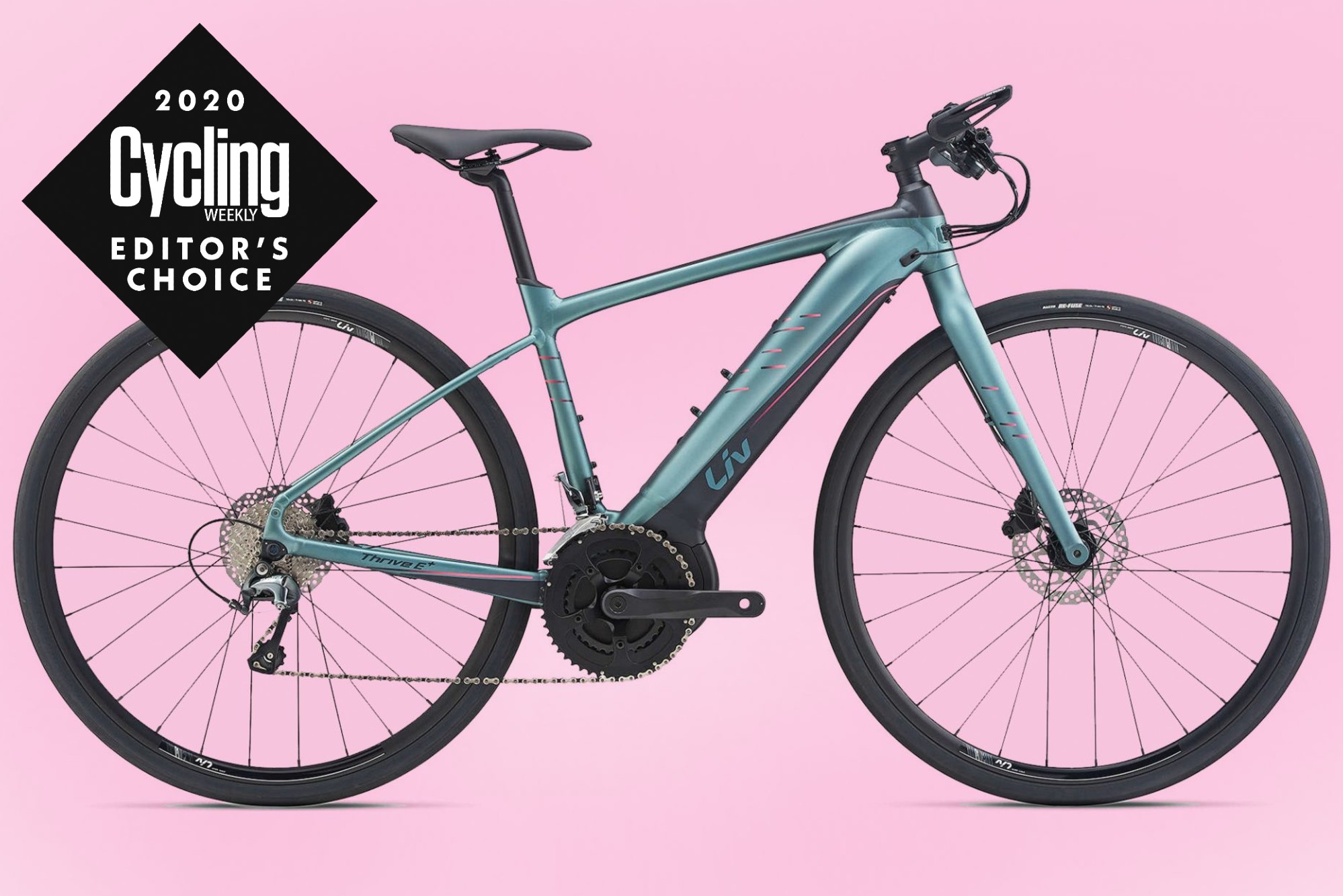Liv Thrive E+ 2 Pro electric bike review
Maria David tests an e-bike as slender as a non-assisted bike, but with the power to perform in multi-terrain settings

The Liv Thrive E+ 2 Pro looks a stylish bike, while still having all the power to give you the assistance you need. Since the battery can be charged on or off the bike, this gives versatility and user-friendliness, ensuring the bike is always powered up and ready to use whether for commuting or for a sporting ride.
-
+
Stylish slimline look
-
+
SyncDrive Pro motor with Smart Assist technology
-
+
Walk assist
-
-
Slightly more expensive than equivalent spec hybrid e-bikes
You can trust Cycling Weekly.

The Liv Thrive E+ was selected for an Editor's Choice award in 2020. This year's list contains 78 items which scored a 9 or 10/10 with our tech team - this gear is the best of the best, and has received the Cycling Weekly stamp of approval. We tested the 2020 model - a 2021 version has since been released, but the frame and spec is very similar.
This is the first foray into women-specific road e-bikes for Liv. There are two models to choose from – the Thrive E+ 1 Pro, which has higher spec components, and the Thrive E+ 2 Pro, which is what I tried. Being 5’5” (1m66) I tried out size S.
Frame
To look at the bike, I must say that I like the metallic turquoise and black design (officially described as silver and pine) of the aluminium frame and fork. The way the battery has been seamlessly integrated within it means it doesn’t look obvious that this is an e-bike. Of course, when riding it, folks will know what this is an e-bike when you sail past them effortlessly on the hills!
I find the design attractive, and that alone makes me want to be seen on the bike. Some e-bikes do look very much like an “electric bike” but this looks more like an ordinary hybrid that happens to have a motor.
Although Liv is attached to Giant, the Thrive E+, like other Liv bikes has been built under the 3F design ethos (fit, form, function) specific to all bikes and taking into account women’s body dimensions, strength patterns, user-friendliness, and exciting designs. The Thrive E+ is like a sporty hybrid and the form mirrors that of the non-assisted hybrid Alight range.
It is also good to see that the bike has other touches to make the Thrive a good utility bike, such mounts for a rack, mudguards, and it comes fitted with a bell too.
The latest race content, interviews, features, reviews and expert buying guides, direct to your inbox!
Motor System
Operating the Thrive E+ and knowing how much battery charge (range) remains is simple and easily done by way of different buttons on the handlebars. On the left-hand side of the handlebars are the controls, known as RideControl One.

There is an on-off button, with five LEDs to the right of it indicating how much range (battery charge) is left. Five LEDs to the left of the on-off button indicate how much power assistance is being given. Separate buttons can increase and decrease the level of power assistance, as well as putting it into ECO mode.
Gears are operated by levers in exactly the same way as on standard hybrids. When pedalling along, even when on low assistance or no assistance at all, I can still feel the traction in the crank area which makes pedalling action smooth, and requires less effort than when on a non-assisted bicycle.
This sensation is probably thanks to the Giant SyncDrive Pro motor, powered by Yamaha, and built into the frame - this drives the chain directly. With Smart Assist Technology (Pedal Plus 6-sensor technology) this means that when pedalling, sensors pick up the amount of power you transmit through the pedals and can then calculate the amount of assistance needed, and replicate your pedalling style. So the result is a smooth natural feel when pedalling.
Furthermore, this will give an optimised range when setting out with a fully charged bike. Battery consumption varies depending on which of the six assistance settings are used.
I tend to use the lowest assistance setting most of the time when riding around Central London, which is largely flat, and I have a tendency to put in a bit of work myself too! For gentle inclines I then move to the second setting, while the third setting works for the steeper hills in South London, at around 10 per cent gradient. For those wanting even more assistance on the hills, or who live in notoriously hilly areas like the Surrey Hills or Sheffield, there are still two further assistance settings to help you.
Of course, the higher the setting used, the shorter the range of the battery. Based on my personal usage, the battery lasted around 110km before it went flat. Consumption would depend on the terrain you ride. In ECO mode, the amount of assistance required automatically adjusts itself depending on the terrain you encounter, and the engagement of the SyncDrive motor.
Another setting, which is via a button at the bottom of the control panel, is walk assist. This is really useful if you have to wheel the bike up a ramp. This is particularly useful given that the bike weighs 18.5kg.

Talking of battery, the Liv Thrive E+ 2 Pro is fitted with a Giant EnergyPak 375, 36V Integrated Lithium-Ion battery. This type of battery has a lower discharge rate than other batteries on e-bikes, meaning that leaving it unused for a period of a few weeks should not pose a problem.
In addition, this battery can be fully charged to 100 per cent of capacity 1000 times, after which time the battery is fully charged up to 80 per cebt of full capacity 800 more times. Thereafter, charging the battery up to 60 per cent of capacity can be done a further 600 times.
So, for example, if you are commuting by bike 30km per day and doing a 50km social ride at the weekend on mainly flat terrain with the odd hill, you would need to charge the battery twice a week, and it could be 10 years before the battery began to lose capacity! That certainly gives me confidence.
Charging the battery from flat to 100 per cent takes around 3.5-4 hours, and is done using the Giant EnergyPak 6A fast charger. One handy feature is the facility to charge the battery while off the bike, so you don’t need to worry about finding a large and possibly an indoor space for the whole bike. Removing the battery from the bike involves unlocking the casing on the frame and is straightforward. If you are happy to charge up the bike directly without removing the battery, the socket is easy to find and slots easily into the lead.
Components
The gearing is a good range, so you still have assistance for hills care of a 10-speed 11-32 Shimano Tiagra groupset paired with a 34/50 chain ring. If you want more choice of gears the Thrive E + 1 Pro is fitted with and 11-speed Shimano 105 groupset with the same spec chain ring.

Tyres are Maxxis Re-Fuse 32mm Folding MaxxShield tyres, these can be run as tubeless, and are well suited to cope with multi-terrain settings, including light gravel paths. I cycled along the Wandle Trail, a multi-terrain track in South London and the bike more than coped in all of those areas. Shimano MT201 hydraulic disc brakes provides confidence too when on undulating roads and tracks.
Performance
Although the Thrive E+ is set up for a sporty ride, comfort is not compromised as a women-specific Liv Sport saddle is fitted to the aluminium seatpost. Regarding speed, bear in mind that the motor on the Thrive E+ 2 Pro limits the maximum speed to 25km/h (15.5mph) and a battery power of 250 Watts, a legal requirement in the UK. Of course, if you cut out the engine and let the bike plummet down a hill you can decide how fast you want to go!
Value
At £2,749 the Liv Thrive E+ 2 Pro may seem a little steep compared with other hybrid e-bikes. However, the quality frame and motor, along with the Smart Assist Technology come at a price. This is by no means at the high end, and this price point represents good value given that the components are designed to last for a lot longer than a couple of years.
Maria David is a freelance writer who spent five years living and working in Paris
